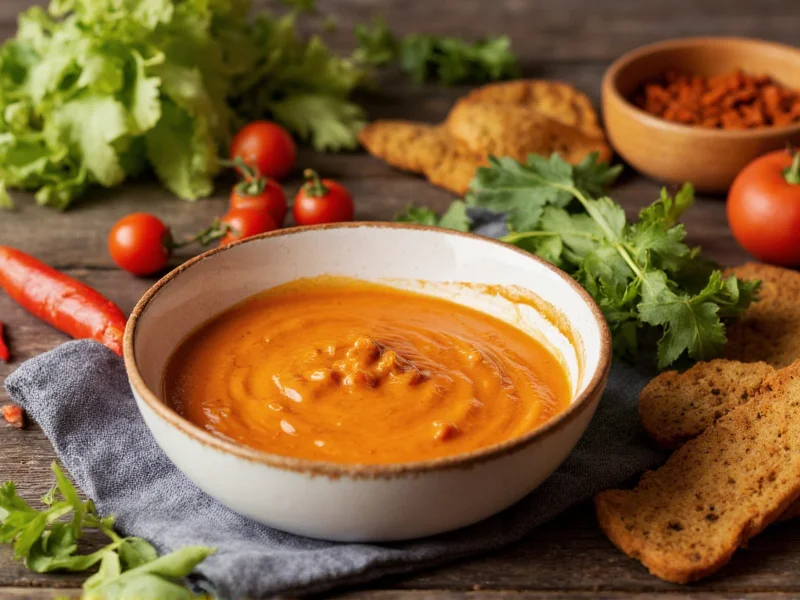Ancho chile aioli bridges traditional Mexican flavors with French culinary technique, creating a sauce that elevates everyday dishes with minimal effort. Understanding this fusion condiment begins with recognizing that 'ancho' refers to dried poblano peppers, not a specific chile variety. When properly prepared, ancho chile aioli delivers a sophisticated flavor experience far beyond basic spicy mayo, with nuanced notes of dried fruit, tobacco, and subtle earthiness complementing the creamy base.
Understanding Ancho Chile Aioli Components
The magic of authentic ancho chile aioli comes from the careful integration of three key elements: the chile component, the emulsion base, and the flavor enhancers. Unlike standard spicy mayonnaise, true ancho chile aioli requires proper preparation of the dried chiles to extract their full flavor potential without bitterness.
| Component | Key Ingredients | Function |
|---|---|---|
| Ancho Chile Base | Dried ancho chiles, hot water, salt | Provides smoky depth, mild heat, and earthy sweetness |
| Emulsion Base | Quality mayonnaise, olive oil (optional) | Creates creamy texture and carries flavors |
| Flavor Enhancers | Garlic, lime juice, cumin, smoked paprika | Balances acidity, adds brightness, and complements chile notes |
Essential Ingredients Explained
The quality of your ancho chile aioli depends entirely on proper ingredient selection and preparation. Ancho chiles (dried poblanos) should be deep burgundy with intact skin and flexible texture—avoid brittle, broken, or moldy specimens. Proper rehydration unlocks their complex flavor profile while minimizing bitterness.
For the emulsion base, choose a high-quality mayonnaise with clean ingredients. While homemade aioli provides superior texture, quality store-bought versions work well for this application. The garlic should be fresh and firm, never sprouted or soft. Freshly squeezed lime juice makes a noticeable difference compared to bottled alternatives.
Authentic Ancho Chile Aioli Recipe
This tested recipe yields approximately 1.5 cups of vibrant ancho chile aioli with balanced heat and complex flavor. The preparation method focuses on proper chile treatment to avoid bitterness while maximizing flavor extraction.
Ingredients
- 2-3 dried ancho chiles (about 15g), stems and seeds removed
- 1 cup hot water (not boiling)
- 1 cup quality mayonnaise
- 2 large garlic cloves, minced
- 1 tablespoon fresh lime juice
- 1/2 teaspoon ground cumin
- 1/4 teaspoon smoked paprika
- 1/4 teaspoon salt, plus more to taste
- 1-2 tablespoons olive oil (optional, for smoother texture)
Step-by-Step Preparation
- Prepare the chiles: Remove stems and seeds from dried anchos. Place in a heatproof bowl and cover with hot water. Let soak for 15-20 minutes until completely softened but not disintegrating.
- Drain and process: Drain chiles, reserving 2 tablespoons soaking liquid. Transfer chiles to blender or food processor with reserved liquid, garlic, lime juice, cumin, smoked paprika, and salt.
- Create chile puree: Blend until completely smooth, scraping down sides as needed. This should take 1-2 minutes for proper texture.
- Emulsify: With blender running on low, slowly drizzle in mayonnaise until fully incorporated. Add olive oil if needed for desired consistency.
- Rest and adjust: Transfer to container, cover, and refrigerate for at least 2 hours before serving. Adjust salt or lime juice to taste after resting.
Perfecting Your Ancho Chile Aioli
Achieving restaurant-quality ancho chile aioli requires attention to several critical details. The soaking time for dried chiles significantly impacts flavor—under-soaked chiles yield bitter notes while over-soaked chiles become muddy. The ideal texture resembles thick tomato paste after soaking.
When blending, patience is essential. Rushing the process leaves fibrous bits that compromise the smooth texture characteristic of quality aioli. For extra-smooth results, strain the chile puree through a fine-mesh sieve before combining with mayonnaise.
The resting period serves two crucial functions: it allows flavors to meld and integrates the chile oil into the emulsion. Never skip this step—freshly made aioli lacks depth and balance compared to properly rested sauce.
Optimal Pairings and Serving Suggestions
Ancho chile aioli's versatility makes it suitable for numerous applications beyond standard dipping. Its moderate heat level (2,500-3,000 Scoville units) and complex flavor profile complement various proteins and vegetables without overwhelming them.
| Dish Category | Recommended Application | Flavor Synergy |
|---|---|---|
| Tacos & Burritos | Drizzle over carnitas or fish tacos | Complements smoky meats while cutting richness |
| Grilled Proteins | Accompaniment for chicken, pork, or shrimp | Enhances charred notes without overpowering |
| Vegetable Dishes | Roasted sweet potatoes or grilled zucchini | Contrasts natural sweetness with smoky depth |
| Sandwiches & Wraps | Spread on turkey or veggie wraps | Adds moisture and complex flavor dimension |
Storage and Shelf Life Guidelines
Properly stored ancho chile aioli maintains quality for 5-7 days in the refrigerator. Transfer to an airtight container immediately after preparation, pressing plastic wrap directly onto the surface before sealing to minimize oxidation. The vibrant color will gradually darken over time, which is normal.
Do not freeze ancho chile aioli as the emulsion will break upon thawing, resulting in a watery, separated texture. Always use clean utensils when serving to prevent contamination. Discard if you notice any off smells, mold, or significant separation that doesn't reincorporate with stirring.
Customization Options and Variations
Once you've mastered the basic ancho chile aioli recipe, numerous customization options allow you to tailor it to specific dishes or preferences. For increased heat, add a pinch of cayenne or a small amount of chipotle powder. To enhance smokiness without additional heat, increase the smoked paprika proportion.
For herbaceous variations, blend in fresh cilantro or oregano after the initial emulsion. Some chefs incorporate a small amount of honey or maple syrup to highlight the natural sweetness of the ancho chiles. Vegan versions work well using high-quality vegan mayonnaise as the base.











 浙公网安备
33010002000092号
浙公网安备
33010002000092号 浙B2-20120091-4
浙B2-20120091-4